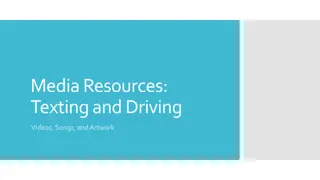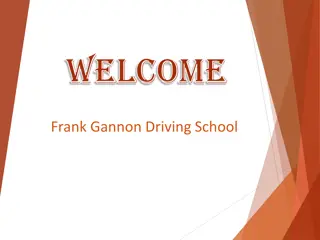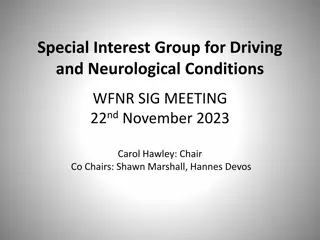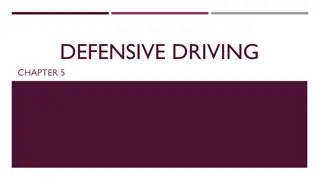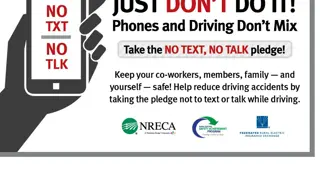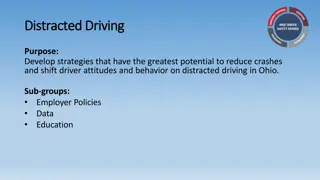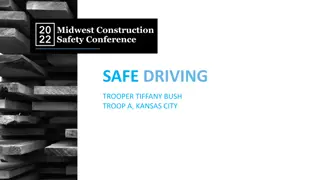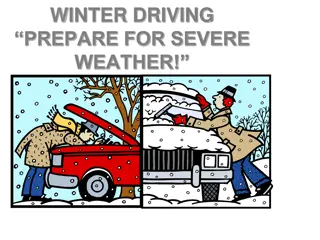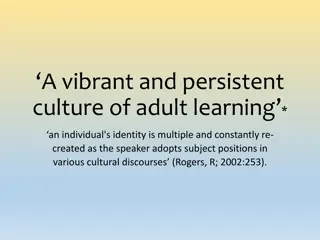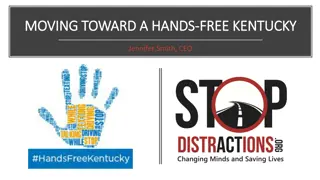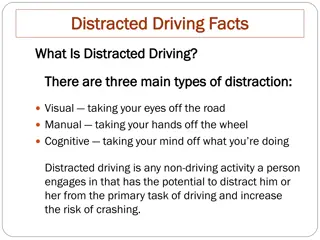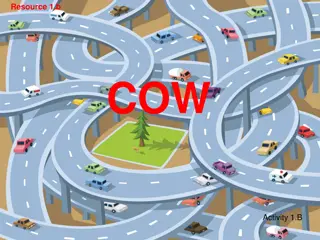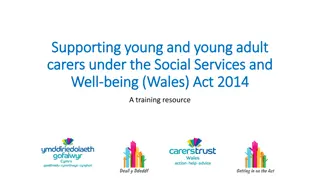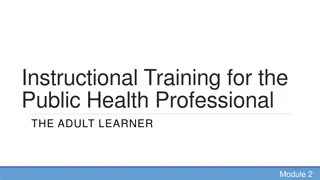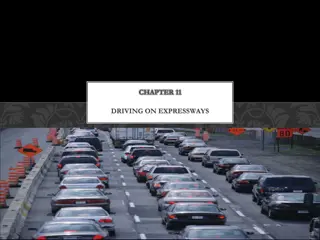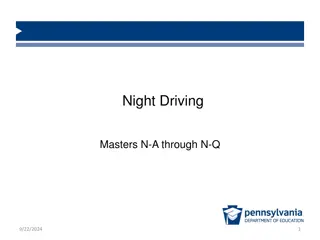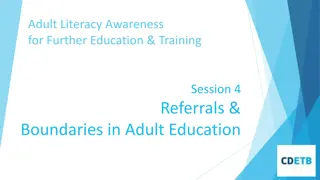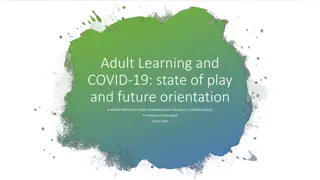Understanding and Preventing Young Adult Distracted Driving Research Program
Research explores distracted driving among young adults, highlighting the increased crash risk and vulnerability of this demographic. Studies identify personality traits and driving behaviors, aiming to develop strategies to reduce distracted driving instances. The focus is on addressing the challenges faced by young drivers to enhance road safety.
Download Presentation

Please find below an Image/Link to download the presentation.
The content on the website is provided AS IS for your information and personal use only. It may not be sold, licensed, or shared on other websites without obtaining consent from the author. Download presentation by click this link. If you encounter any issues during the download, it is possible that the publisher has removed the file from their server.
E N D
Presentation Transcript
Understanding and preventing young adult distracted driving Keli A. Braitman & Abby L. Braitman 8th Annual Distracted Driving Summit Virginia Beach September 16-17, 2021
Distracted driving Any activity that diverts driver attention away from the primary task of driving. Distracted driving (in any form) was involved in 3,142 fatalities in the United States in 2019 (NHTSA, 2021) Bans on hand-held cellphone use have been shown to reduce (but not eliminate) phone use among drivers, but not distracted driving crashes. This is because driver distraction is broader than phone use. There is some emphasis on vehicle technology to prevent distraction. But it may be that drivers themselves will need to play a role in reducing distractions.
Young drivers and distracted driving It is clear from research that there is an increased crash risk with distraction, and that young drivers are particularly vulnerable. Young drivers have crash rates (per mile driven) that are nearly 4 times higher than those of drivers 20 and older (IIHS, 2021) They are also less experienced drivers, and less likely to know how to respond to hazards Given these challenges, it is particularly important to find ways to reduce young driver distracted driving
Our program of research in young driver distracted driving Study 1 Identified naturally occurring profiles of distracted driving behaviors; distinguished personality traits associated with these profiles Study 2 Examined the role of perceived norms in distracted driving behavior Study 3 (Current) Developing measure to identify strategies young drivers use (or could use) to prevent distracted driving.
Study 1 Personality types of distracted drivers
Participants 266 young adult drivers (from 2 U.S. higher-education institutions) competed online self-report surveys that included questions about distracted driving behaviors and personality characteristics
Distracted driving survey 35 items assessed the frequency with which respondents engage in potentially distracting activities while driving, ranging from 1 (Never) to 5 (Every time I drive). Items were developed by the researchers in consultation with colleagues and students.
Sample activities include: Making hand-held phone calls Making hands-free phone calls Read text messages Send text messages Program music Look at paper map Using navigation Watch videos Eat or drink Talk with passenger(s) Put on make-up or other grooming
Sample activities include: Making hand-held phone calls Making hands-free phone calls Read text messages Send text messages Program music Look at paper map Using navigation Watch videos Eat or drink Talk with passenger(s) Put on make-up or other grooming (Most common behaviors in red)
Distracted driving survey Also rated how distracting each behavior is, from 1 (Not at all distracting) to 5 (Very distracting) Asked whether they talked on their phone, texted, or used their phone in other ways in known high-risk conditions (i.e., during rush hour, free- flowing high speed traffic, stop-and-go traffic, at night, and in bad weather).
Personality survey Big 5 Inventory (John, Donahue, and Kentle, 1991) Agreeableness e.g., Is helpful and unselfish with others Conscientious e.g., Does a thorough job Neuroticism e.g., Gets nervous easily Extraversion e.g., Is talkative Openness to experience e.g., Is curious about many different things
Three classes of distracted drivers Latent profile analysis was used to develop classes of drivers based on how frequently they report engaging in distracted driving behaviors Class 1 (28.9%) LOW DISTRACTED DRIVING class, had the lowest engagement in distracted driving behaviors. Class 2 (53.3%), MEDIUM DISTRACTED DRIVING class, was comprised of the majority of the sample, and represented medial levels of distracted driving behaviors. Class 3 (17.8%), HIGH DISTRACTED DRIVING class, had the highest engagement in distracted driving behaviors.
Class 1 Class 2 Class 3 5 4.5 Frequency of Engagement 4 3.5 3 2.5 2 1.5 1 0.5 0 Distracting Behaviors
Relationship with personality Wald tests of mean equalities were used to examine differences in personality among the 3 classes of distracted drivers Class 1: LOW DISTRACTED DRIVING 3.10a Class 2: MEDIUM DISTRACTED DRIVING 3.40b Class 3: HIGH Variable DISTRACTED DRIING Extraversion 3.60b Agreeableness 3.87 3.92 3.82 Conscientiousness Neuroticism 3.69 2.88 3.67 2.69 3.68 2.89 Openness 3.60 3.45 3.35 Note. Means with differing superscripts within rows are significantly different at the p < .05 level
Perceptions of distraction Drivers rated how distracting each of the behaviors (e.g., making hand-held phone calls; make hands-free phone calls; reading text messages; talking with a passenger; eating or drinking, etc.) is on a 5-point scale Interestingly, the HIGH distracted driving group rated these behaviors as fairly distracting, but reported engaging in them most frequently.
Conclusions Extraversion emerged as a risk factor predictive of engaging in high risk behaviors while driving, even in high-risk driving situations. The group of drivers that reported the highest amount of distracted driving rated the behaviors fairly high in terms of perceived level of distraction, yet did them anyway. Findings suggest that highly extraverted individuals are more compelled to talk or text while driving despite reporting that such behaviors are distracting.
Study 1 revealed that drivers who engage in distracted driving the most still recognize that this is highly distracting. Why do they do this? Study 2 Examined the role of perceived norms in distracted driving behavior
Types of norms Descriptive norms How often someone thinks their peers engage in a given behavior e.g., How much do they think their friends engage in distracted driving Injunctive norms Perception of how acceptable someone thinks their peers find a behavior e.g., How acceptable do they think their friends think distracted driving is?
Methodology 408 undergraduate students (young adult drivers) completed an online survey Completed the distracted driving survey from Study 1 Measure of of descriptive norms How often they think a typical student at their institution engages in each distracted driving behavior (5-point response scale) Measure of injunctive norms Perceived level of acceptability by typical student at their institution for each distracted driving behavior (5-point response scale)
Findings Particularly strong correlation between descriptive norms and frequency of distracted driving; r = .42, r2 = .180, p < .001 This is a medium to large effect
Conclusions Young drivers perceptions of how frequently others engage in distracted driving correlate with how much drivers themselves engage in distracted driving These may be promising avenues for campaigns to help reduce young driver distracted driving
Study 1 Identified who was at most risk extraverted young drivers Study 2 Dispelling normative misperceptions could motivate young drivers to reduce their own distractions behind the wheel How can young drivers successfully curb distracted driving? What strategies do they use? Study 3 (ongoing) Examine strategies young drivers use to prevent distraction
Step 1: Focus groups Focus groups with young adult drivers were conducted to learn about their strategies for avoiding distracted driving. The drivers were college students who participated for course credit or to be entered in a raffle for a gift card. 25 strategies emerged. Shared with student researchers who reviewed the list for clarity and to indicate if any other strategies should be included.
Example of strategies: Pre-create music for driving (for example, phone playlist for driving, bringing CDs) Limit passengers Pull over to eat, use phone, or other distraction Use apps to block notifications when driving Silence notifications Put phone out of sight (for example, in pocket, face down) Memorize route before trip Type in address to GPS before you start driving
Step 2: Scale development Survey administered to 157 young adult drivers (Aiming for 500) Strategies for curbing distracted driving 25 items that emerged from the focus groups 4-point response scale: 0 = Never through 3 = Always Distracted driving survey (from Study 1) Attachment to Phone survey
Preliminary Findings Data collection is ongoing n = 157 participants Aiming for 500
Exploratory Factor Analysis With initial data, the one-factor solution was the best fit This suggests the tendency to engage in strategies to avoid distracted driving may be a singular construct rather having multiple subscales (types of strategies) Some items had low factor loadings and may be eliminated pending more data
Most common strategies Type address in GPS before driving Use phone hands-free for talking Have a passenger help with non-driving tasks (e.g., navigate, send texts, unwrap food) Use a button on the steering wheel to change music Pre-create music for driving (e.g. phone play-list) Only interact with a phone when stopped (e.g., at a light) Use phone hands-free for other functions like placing or making calls or dictating text
Initial correlations: Curbing strategies, phone addiction, and distracted driving Young drivers who are more attached to their phones are more likely to engage in distracted driving (+.15) and less likely to use curbing strategies (-.28). Also, the more strategies young drivers use to curb distracted driving, the less they engage in such behaviors (-.12). However, this relationship may be more nuanced than it appears.
Regression suggested both linear ( = -0.23, p = .017) and quadratic = 0.27, p = .004) countermeasures significantly predict distracted driving
Implications and future research More data will shed light on the relationship between distracted driving and strategies to curb such behaviors Targeted interventions may focus on higher risk individuals those who are extraverted and more attached to their phones Interventions that provide personalized normative feedback (dispel misconceptions about their peers behavior) may be a promising approach Dispelling normative misperceptions and providing strategies for avoiding distracted driving could also be addressed in driver education for all new drivers
Thank you! Keli Braitman: braitmank@william.jewell.edu Abby Braitman: abraitma@odu.edu



